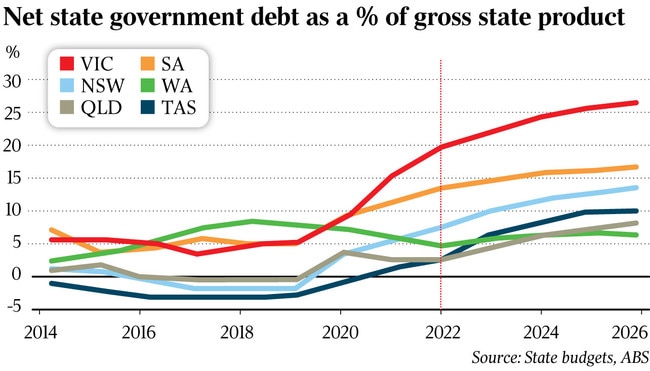Victoria more like a basket case, says damning economic review
A new snapshot of the Victorian economy finds it has the debt and deficit, highest tax as a share of GSP and fastest growing public sector wage bill of any state.

Victoria has the largest state budget deficit in the nation, the largest state government debt, the highest level of taxation as a share of the economy, the fastest-growing government spending rate as a share of the state’s economy, and the fastest-growing public sector wage bill.
These are some of the points highlighted in a pre-election assessment of Victoria’s economy, which argues the state is more vulnerable than others amid a darkening global economic outlook.
“On all critical financial indicators, Victoria is the nation’s worst-performing state by a significant and growing margin, and it will be mainstream Victorians who pay the price,” said report author Daniel Wild, who is deputy executive director of free market think tank the Institute of Public Affairs.
The report highlights the fact that Victoria’s current level of net debt – $101.9bn – compares with the post-Cain-Kirner recession peak of $18.8bn in 1995 (equivalent to $35.8bn in today’s currency).
Since Labor won government in 2014, net debt as a percentage of GSP has quadrupled from 5 per cent to 20 per cent, and is projected to increase to 25 per cent by the middle of the decade.
During the post-Cain-Kirner recession, debt as a percentage of GSP peaked at 16 per cent in 1993.
Modelling a scenario, consistent with market expectations, where interest rates increase from 1.85 per cent to 5 per cent by 2030, the report finds that annual interest payments on Victorian state government debt are set to increase to $18.25bn by the end of the decade.
This would mean that interest payments on debt would become the third largest expenditure item in the budget, behind only health and education.
Victoria has the largest budget deficit of any Australian state, and its budget deficit as a percentage of GSP has plummeted to 3.6 per cent, from a surplus of 0.2 per cent in 2019.
The next worst performing state is NSW, with a budget deficit of 2.4 per cent of GSP.
Victorian Treasurer Tim Pallas’s May budget has the state posting deficits over the next three financial years, before returning to surplus in 2026, based on what Mr Wild describes as “very optimistic economic growth forecasts”.

The report finds the Victorian government’s spending has increased by approximately 10 per cent per year, compared with an average among the over states of 6 per cent.
In percentage terms, government spending has increased by 109 per cent since 2014, with the non-Victorian average sitting at 63 per cent.
NSW is the state with the next fastest growing spending, recording an 85 per cent increase since 2014.
The report also finds Victoria has the fastest-growing public sector wages in Australia, with an average annual growth rate of 3.7 per cent since 2014, compared with the non-Victorian average of 2 per cent.
An Andrews government spokesman said Labor had “used our balance sheet to protect Victorian lives and jobs and our economy now is rated the fastest growing and best performing in the country”.
“Only Labor is doing what matters and building the hospitals, schools and infrastructure that families need – and we have a clear plan to return the budget to surplus and stabilise pandemic debt without cuts to the projects and services Victorians rely on,” the spokesman said.
The Labor government said interest payments would average about 6 per cent of revenue over the forward estimates – compared with a peak of 14 per cent in the 1990s.
Federal government debt is forecast to reach 33.1 per cent of GDP in 2025-26, compared with a Victorian peak of 26.5 per cent of GSP.
Victoria was rated Number One in the most recent CommSec State of the States quarterly report, which highlighted growth in jobs, retail trade and construction activity.
State Final Demand growth in Victoria for 2021-22, as measured by the Australian Bureau of Statistics, was 40 per cent higher than the national average.




To join the conversation, please log in. Don't have an account? Register
Join the conversation, you are commenting as Logout